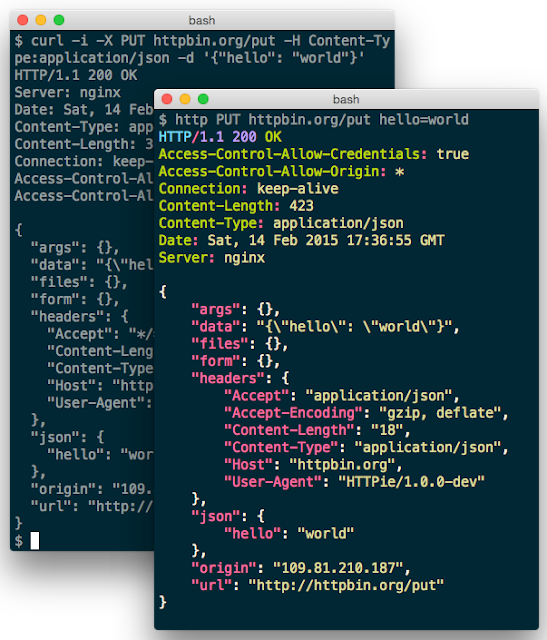HTTPie - a CLI, cURL - Like Tool For Humans
HTTPie (pronounced aych-tee-tee-pie) is a command line HTTP client. Its goal is to make CLI interaction with web services as human-friendly as possible. It provides a simple
http command that allows for sending arbitrary HTTP requests using a simple and natural syntax, and displays colorized output. HTTPie can be used for testing, debugging, and generally interacting with HTTP servers.HTTPie is written in Python, and under the hood it uses the excellent Requests and Pygments libraries.
Main Features
- Expressive and intuitive syntax
- Formatted and colorized terminal output
- Built-in JSON support
- Forms and file uploads
- HTTPS, proxies, and authentication
- Arbitrary request data
- Custom headers
- Persistent sessions
- Wget-like downloads
- Python 2.6, 2.7 and 3.x support
- Linux, Mac OS X and Windows support
- Plugins
- Documentation
- Test coverage
On Mac OS X, HTTPie can be installed via Homebrew:
$ brew install httpie# Debian-based distributions such as Ubuntu:
$ apt-get install httpie
# RPM-based distributions:
$ yum install httpie# Make sure we have an up-to-date version of pip and setuptools:
$ pip install --upgrade pip setuptools
$ pip install --upgrade httpiepip installation fails for some reason, you can try easy_install httpie as a fallback.)Development version
The latest development version can be installed directly from GitHub:
# Mac OS X via Homebrew
$ brew install httpie --HEAD
# Universal
$ pip install --upgrade https://github.com/jkbrzt/httpie/tarball/masterUsage
Hello World:
$ http httpie.org$ http [flags] [METHOD] URL [ITEM [ITEM]]http --help.Examples
Custom HTTP method, HTTP headers and JSON data:
$ http PUT example.org X-API-Token:123 name=John$ http -f POST example.org hello=World$ http -v example.org$ http -a USERNAME POST https://api.github.com/repos/jkbrzt/httpie/issues/83/comments body='HTTPie is awesome!'$ http example.org < file.json$ http example.org/file > filewget style:$ http --download example.org/file$ http --session=logged-in -a username:password httpbin.org/get API-Key:123$ http --session=logged-in httpbin.org/headersHost header to work around missing DNS records:$ http localhost:8000 Host:example.comWhat follows is a detailed documentation. It covers the command syntax, advanced usage, and also features additional examples.
HTTP Method
The name of the HTTP method comes right before the URL argument:
$ http DELETE example.org/todos/7Request-Line that is sent:DELETE /todos/7 HTTP/1.1METHOD argument is omitted from the command, HTTPie defaults to either GET (with no request data) or POST(with request data).Request URL
The only information HTTPie needs to perform a request is a URL. The default scheme is, somewhat unsurprisingly,
http://, and can be omitted from the argument – http example.org works just fine.Additionally, curl-like shorthand for localhost is supported. This means that, for example
:3000 would expand tohttp://localhost:3000 If the port is omitted, then port 80 is assumed.$ http :/fooGET /foo HTTP/1.1
Host: localhost$ http :3000/barGET /bar HTTP/1.1
Host: localhost:3000$ http :GET / HTTP/1.1
Host: localhostparam==value syntax for appending URL parameters so that you don't have to worry about escaping the & separators. To search for HTTPie on Google Images you could use this command:$ http GET www.google.com search==HTTPie tbm==ischGET /?search=HTTPie&tbm=isch HTTP/1.1
DOWNLOAD LINK - WEBSITE


Comments
Post a Comment